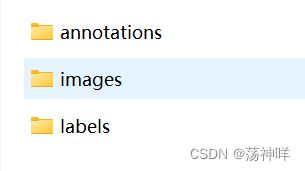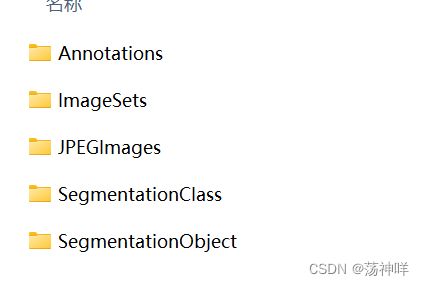coco数据集和voc数据集的划分与使用
一、coco2017的目录结构

但coco数据集太大了,划分至原来的四分之一(参考链接):
# coding:utf8
__first_version_author__ = 'tylin'
__second_version_author__ = 'wfnian'
# Interface for accessing the Microsoft COCO dataset.
# Microsoft COCO Toolbox. version 2.0
# Data, paper, and tutorials available at: http://mscoco.org/
# Code written by Piotr Dollar and Tsung-Yi Lin, 2014.
# Licensed under the Simplified BSD License [see bsd.txt]
import json
import time
import shutil
import os
from collections import defaultdict
import json
from pathlib import Path
class COCO:
def __init__(self, annotation_file=None, origin_img_dir=""):
"""
Constructor of Microsoft COCO helper class for reading and visualizing annotations.
:param annotation_file (str): location of annotation file
:param image_folder (str): location to the folder that hosts images.
:return:
"""
# load dataset
self.origin_dir = origin_img_dir
self.dataset, self.anns, self.cats, self.imgs = dict(), dict(), dict(), dict() # imgToAnns 一个图片对应多个注解(mask) 一个类别对应多个图片
self.imgToAnns, self.catToImgs = defaultdict(list), defaultdict(list)
if not annotation_file == None:
print('loading annotations into memory...')
tic = time.time()
dataset = json.load(open(annotation_file, 'r'))
assert type(dataset) == dict, 'annotation file format {} not supported'.format(type(dataset))
print('Done (t={:0.2f}s)'.format(time.time() - tic))
self.dataset = dataset
self.createIndex()
def createIndex(self):
# create index 给图片->注解,类别->图片建立索引
print('creating index...')
anns, cats, imgs = {}, {}, {}
imgToAnns, catToImgs = defaultdict(list), defaultdict(list)
if 'annotations' in self.dataset:
for ann in self.dataset['annotations']:
imgToAnns[ann['image_id']].append(ann)
anns[ann['id']] = ann
if 'images' in self.dataset:
for img in self.dataset['images']:
imgs[img['id']] = img
if 'categories' in self.dataset:
for cat in self.dataset['categories']:
cats[cat['id']] = cat
if 'annotations' in self.dataset and 'categories' in self.dataset:
for ann in self.dataset['annotations']:
catToImgs[ann['category_id']].append(ann['image_id'])
print('index created!')
# create class members
self.anns = anns
self.imgToAnns = imgToAnns
self.catToImgs = catToImgs
self.imgs = imgs
self.cats = cats
def build(self, tarDir=None, tarFile='./new.json', N=1000):
load_json = {'images': [], 'annotations': [], 'categories': [], 'type': 'instances', "info": {"description": "This is stable 1.0 version of the 2014 MS COCO dataset.", "url": "http:\/\/mscoco.org", "version": "1.0", "year": 2014, "contributor": "Microsoft COCO group", "date_created": "2015-01-27 09:11:52.357475"}, "licenses": [{"url": "http:\/\/creativecommons.org\/licenses\/by-nc-sa\/2.0\/", "id": 1, "name": "Attribution-NonCommercial-ShareAlike License"}, {"url": "http:\/\/creativecommons.org\/licenses\/by-nc\/2.0\/", "id": 2, "name": "Attribution-NonCommercial License"}, {"url": "http:\/\/creativecommons.org\/licenses\/by-nc-nd\/2.0\/",
"id": 3, "name": "Attribution-NonCommercial-NoDerivs License"}, {"url": "http:\/\/creativecommons.org\/licenses\/by\/2.0\/", "id": 4, "name": "Attribution License"}, {"url": "http:\/\/creativecommons.org\/licenses\/by-sa\/2.0\/", "id": 5, "name": "Attribution-ShareAlike License"}, {"url": "http:\/\/creativecommons.org\/licenses\/by-nd\/2.0\/", "id": 6, "name": "Attribution-NoDerivs License"}, {"url": "http:\/\/flickr.com\/commons\/usage\/", "id": 7, "name": "No known copyright restrictions"}, {"url": "http:\/\/www.usa.gov\/copyright.shtml", "id": 8, "name": "United States Government Work"}]}
if not Path(tarDir).exists():
Path(tarDir).mkdir()
for i in self.imgs:
if(N == 0):
break
tic = time.time()
img = self.imgs[i]
load_json['images'].append(img)
fname = os.path.join(tarDir, img['file_name'])
anns = self.imgToAnns[img['id']]
for ann in anns:
load_json['annotations'].append(ann)
if not os.path.exists(fname):
shutil.copy(self.origin_dir+'/'+img['file_name'], tarDir)
print('copy {}/{} images (t={:0.1f}s)'.format(i, N, time.time() - tic))
N -= 1
for i in self.cats:
load_json['categories'].append(self.cats[i])
with open(tarFile, 'w+') as f:
json.dump(load_json, f, indent=4)
coco = COCO('../../datasets/coco/annotations/instances_train2017.json',
origin_img_dir='../../datasets/coco/train2017') # 完整的coco数据集的图片和标注的路径
coco.build('./mini_train2017', './mini_instances_train2017.json', 29568) # 保存图片路径
coco = COCO('../../datasets/coco/annotations/instances_val2017.json',
origin_img_dir='../../datasets/coco/val2017') # 完整的coco数据集的图片和标注的路径
coco.build('./mini_val2017', './mini_instances_val2017.json', 1250) # 保存图片路径
# 在2017年数据集中,训练集118287张,验证5000张,测试集40670张.
# 118287/4 = 29568 5000/4 = 1250
划分后结构如下:

在代码的coco.yaml文件中,更改如下语句:
path: E:\code\yolo\yolov5-2\coco\images\
# dataset root dir /coco #E:/dataset/coco/
train: train2017 # train images (relative to 'path') 118287 images train2017.txt
val: val2017 # train images (relative to 'path') 5000 images val2017.txt
#test: test-dev2017.txt # 20288 of 40670 images, submit to https://competitions.codalab.org/competitions/20794
二、voc2012
1、目录结构如下:

目标检测只需要前三个文件夹。
ImageSets中除去main的文件夹都可以删掉,main中的所有txt文件也可以删掉,一般都是自己划分。
在此之前将JPEGImages文件夹改名为images。(该步非常重要,否则会找不到标签)
现在目录结构为:

在根目录(这三个文件夹的同一路径下)创建split_train_val.py,将voc划分为8:1:1(参考链接):
# -*- coding: utf-8 -*-
"""
Author:smile
Date:2022/09/11 10:00
顺序:脚本A1
简介:分训练集、验证集和测试集,按照 8:1:1 的比例来分,训练集8,验证集1,测试集1
"""
import os
import random
import argparse
parser = argparse.ArgumentParser()
# xml文件的地址,根据自己的数据进行修改 xml一般存放在Annotations下
parser.add_argument('--xml_path', default='E:/dataset/VOC2012ok/Annotations/', type=str, help='input xml label path')
# 数据集的划分,地址选择自己数据下的ImageSets/Main
parser.add_argument('--txt_path', default='E:/dataset/VOC2012ok/ImageSets/Main/', type=str, help='output txt label path')
opt = parser.parse_args()
train_percent = 0.8 # 训练集所占比例
val_percent = 0.1 # 验证集所占比例
test_persent = 0.1 # 测试集所占比例
xmlfilepath = opt.xml_path
txtsavepath = opt.txt_path
total_xml = os.listdir(xmlfilepath)
if not os.path.exists(txtsavepath):
os.makedirs(txtsavepath)
num = len(total_xml)
list = list(range(num))
t_train = int(num * train_percent)
t_val = int(num * val_percent)
train = random.sample(list, t_train)
num1 = len(train)
for i in range(num1):
list.remove(train[i])
val_test = [i for i in list if not i in train]
val = random.sample(val_test, t_val)
num2 = len(val)
for i in range(num2):
list.remove(val[i])
file_train = open(txtsavepath + '/train.txt', 'w')
file_val = open(txtsavepath + '/val.txt', 'w')
file_test = open(txtsavepath + '/test.txt', 'w')
for i in train:
name = total_xml[i][:-4] + '\n'
file_train.write(name)
for i in val:
name = total_xml[i][:-4] + '\n'
file_val.write(name)
for i in list:
name = total_xml[i][:-4] + '\n'
file_test.write(name)
file_train.close()
file_val.close()
file_test.close()
运行完毕后会在iImageSets-Main文件夹下生成三个txt文件。

再创建voc_label.py:
# -*- coding: utf-8 -*-
import xml.etree.ElementTree as ET
import os
sets = ['train', 'val', 'test'] # 如果你的Main文件夹没有test.txt,就删掉'test'
# classes = ["a", "b"] # 改成自己的类别,VOC数据集有以下20类别
classes = ["aeroplane", 'bicycle', 'bird', 'boat', 'bottle', 'bus', 'car', 'cat', 'chair', 'cow', 'diningtable', 'dog',
'horse', 'motorbike', 'person', 'pottedplant', 'sheep', 'sofa', 'train', 'tvmonitor'] # class names
abs_path = os.getcwd()
def convert(size, box):
dw = 1. / (size[0])
dh = 1. / (size[1])
x = (box[0] + box[1]) / 2.0 - 1
y = (box[2] + box[3]) / 2.0 - 1
w = box[1] - box[0]
h = box[3] - box[2]
x = x * dw
w = w * dw
y = y * dh
h = h * dh
return x, y, w, h
def convert_annotation(image_id):
in_file = open(abs_path + '/Annotations/%s.xml' % (image_id), encoding='UTF-8')
out_file = open(abs_path + '/labels/%s.txt' % (image_id), 'w')
tree = ET.parse(in_file)
root = tree.getroot()
size = root.find('size')
w = int(size.find('width').text)
h = int(size.find('height').text)
for obj in root.iter('object'):
difficult = obj.find('difficult').text
# difficult = obj.find('Difficult').text
cls = obj.find('name').text
if cls not in classes or int(difficult) == 1:
continue
cls_id = classes.index(cls)
xmlbox = obj.find('bndbox')
b = (float(xmlbox.find('xmin').text), float(xmlbox.find('xmax').text), float(xmlbox.find('ymin').text),
float(xmlbox.find('ymax').text))
b1, b2, b3, b4 = b
# 标注越界修正
if b2 > w:
b2 = w
if b4 > h:
b4 = h
b = (b1, b2, b3, b4)
bb = convert((w, h), b)
out_file.write(str(cls_id) + " " + " ".join([str(a) for a in bb]) + '\n')
for image_set in sets:
if not os.path.exists(abs_path + '/labels/'):
os.makedirs(abs_path + '/labels/')
image_ids = open(abs_path + '/ImageSets/Main/%s.txt' % (image_set)).read().strip().split()
list_file = open(abs_path + '/%s.txt' % (image_set), 'w')
for image_id in image_ids:
list_file.write(abs_path + '/images/%s.jpg\n' % (image_id)) # 要么自己补全路径,只写一半可能会报错
convert_annotation(image_id)
list_file.close()
之后使用数据集用的就是根目录这三个txt文件,train.txt val.txt test.txt.
在使用时,需要修改voc.yaml文件:
path: E:\dataset\VOC2012ok #/VOC
train: train.txt # train images (relative to 'path') 16551 images
val: val.txt # val images (relative to 'path') 4952 images
test: test.txt # test images (optional)
引用:
1、
版权声明:本文为CSDN博主「zstar-_」的原创文章,遵循CC 4.0 BY-SA版权协议,转载请附上原文出处链接及本声明。
原文链接:https://blog.csdn.net/qq1198768105/article/details/125645443
2、https://zhuanlan.zhihu.com/p/423898204
